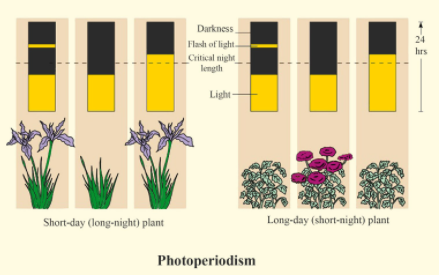
Answer
457.2k+ views
Hint: The photoperiod is defined as the duration of light which each day is received by the plants and the development of the plant depends on the light hours received by it.
Complete answer:
The fixed day length light period below or above of which the plant never blooms is known as critical photoperiod. Different species of plants have different critical photoperiods. On the basis of this, plants are categorized into three types. The three types are as follows:-
-Short Day Plants (SDP):
Short-day plants generally require a light period of but 12 hours i.e. 8-10 hour and a continuous dark period of about 14-16 hour for subsequent flowering. Most of the winter flowering plants belong to the present category e.g. Xanthium, Dahlia, sugarcane, rice, potato.
-Long Day Plants (LDP):
Long day plants require a light period of 14-16 hour for subsequent flowering. The quality of those plants is that a long night period entirely prevents flowering. But sometimes long nights are interrupted by light, even briefly, cause the inhibitive effect of the night to be lost, and therefore the plant's flower. These plants are sometimes also called as short night plants. E.g. Spinach etc.
- Day Neutral Plants:
These plants flower altogether during photoperiods and may blossom throughout the year. Examples are tomato, cucumber, etc. These plants produced more fruits as they require normal conditions.

Note: It is very interesting to note that the photoperiod also affects the milk yielding of the animals. If cows received sunlight for a long time it was recorded that milk yield increased by 8%–10%. In 1920, photoperiod was discovered by Garner and Allard.
Complete answer:
The fixed day length light period below or above of which the plant never blooms is known as critical photoperiod. Different species of plants have different critical photoperiods. On the basis of this, plants are categorized into three types. The three types are as follows:-
-Short Day Plants (SDP):
Short-day plants generally require a light period of but 12 hours i.e. 8-10 hour and a continuous dark period of about 14-16 hour for subsequent flowering. Most of the winter flowering plants belong to the present category e.g. Xanthium, Dahlia, sugarcane, rice, potato.
-Long Day Plants (LDP):
Long day plants require a light period of 14-16 hour for subsequent flowering. The quality of those plants is that a long night period entirely prevents flowering. But sometimes long nights are interrupted by light, even briefly, cause the inhibitive effect of the night to be lost, and therefore the plant's flower. These plants are sometimes also called as short night plants. E.g. Spinach etc.
- Day Neutral Plants:
These plants flower altogether during photoperiods and may blossom throughout the year. Examples are tomato, cucumber, etc. These plants produced more fruits as they require normal conditions.

Note: It is very interesting to note that the photoperiod also affects the milk yielding of the animals. If cows received sunlight for a long time it was recorded that milk yield increased by 8%–10%. In 1920, photoperiod was discovered by Garner and Allard.
Recently Updated Pages
A wire of length L and radius r is clamped rigidly class 11 physics JEE_Main

The number of moles of KMnO4 that will be needed to class 11 chemistry JEE_Main

The oxidation process involves class 11 chemistry JEE_Main

A car starts from rest to cover a distance s The coefficient class 11 physics JEE_Main

The transalkenes are formed by the reduction of alkynes class 11 chemistry JEE_Main

At what temperature will the total KE of 03 mol of class 11 chemistry JEE_Main

Trending doubts
Which is the longest day and shortest night in the class 11 sst CBSE

Why is steel more elastic than rubber class 11 physics CBSE

Difference between Prokaryotic cell and Eukaryotic class 11 biology CBSE

Define the term system surroundings open system closed class 11 chemistry CBSE

In a democracy the final decisionmaking power rests class 11 social science CBSE

In the tincture of iodine which is solute and solv class 11 chemistry CBSE




